- Clinical Technology
- Adult Immunization
- Hepatology
- Pediatric Immunization
- Screening
- Psychiatry
- Allergy
- Women's Health
- Cardiology
- Pediatrics
- Dermatology
- Endocrinology
- Pain Management
- Gastroenterology
- Infectious Disease
- Obesity Medicine
- Rheumatology
- Nephrology
- Neurology
- Pulmonology
Gastrointestinal Disorders-A Photo Essay
Many common GI disorders are seen in the primary care setting. This compact slide show provides visual presentations of a range of these vexing problems.
This colonoscopic view of the ileum shows the moderate to severe inflammation typical of Crohn disease. Many patients have involvement outside of the bowel that manifests as back pain, joint pain, mouth ulcerations, pyoderma gangrenosum in the legs, or erythema nodosum of the shins. These extraintestinal “red herrings” can obscure the diagnosis of inflammatory bowel disease in the absence of a high index of suspicion.
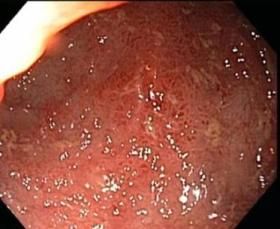
Image courtesy of David Schwartz, MD.
Click here for the next image
A previously healthy man had 10 to 15 episodes daily of small-volume bloody diarrhea with intermittent paraumbilical pain. A colonoscopy showed diffuse ulceration with loss of vascularity and mucosal surfaces from the rectum to the cecum. Distinct, irregular, raised areas of normal-appearing mucosa were noted among the areas of friability, fibrous stranding, and ulceration (arrow). The patient had ulcerative colitis with pseudopolyps.
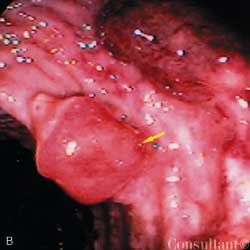
Image courtesy of Chad M. Sisk, DO.
Click here for the next image
A 25-year-old woman complained of intermittent solid food dysphagia. She had been treated 5 years earlier with an 8-week course of lansoprazole that was not effective. This esophagogastroduodenoscopy shows linear furrowing with trachealization. Tissue biopsy specimens confirmed a diagnosis of eosinophilic esophagitis.
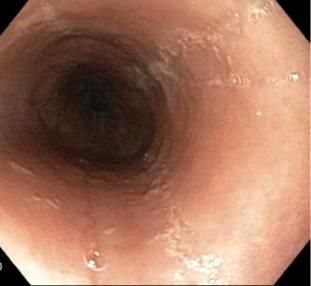
Image courtesy of Amilcar Morales, MD, Anish Patel, DO, and Carlos Angueira, MD.
Click here for the next image
Extensive diverticulosis was found throughout the length of the colon of an 84-year-old woman, who depended on a weekly dose of magnesium citrate to have a bowel movement. Typical lesions are shown here. Diverticula may occur singly or clustered in small groups, with narrow or broad openings into the colonic lumen.
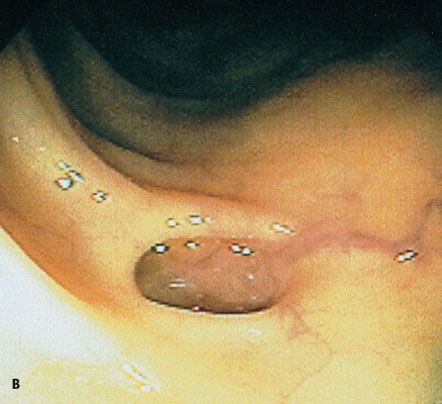
Image courtesy of Benjamin J. Marano Jr, MD and Hal J. Freiman, MD.
Click here for the next image
An active area of bleeding in the duodenum or jejunum was seen on a 55-year-old man’s capsule endoscopy. A 2-cm ulcerated submucosal mass 50 cm distal to the pylorus was found on this single-balloon enteroscopy. An abdominal CT scan revealed a single exophytic jejunal mass. Caf au lait spots, neurofibromas, and axillary freckling were identified on a detailed dermatologic evaluation. The findings were consistent with neurofibromatosis type I. Pathologic examination of the jejunal mass after surgical resection confirmed gastrointestinal stromal tumor.
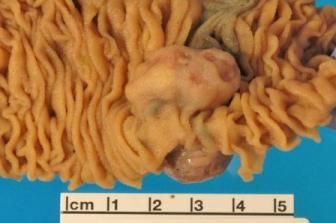
Image courtesy of Reena Julka, MD and Jacqueline Keedy, MD.
Click here for the next image
A 68-year-old woman had watery, yellowish diarrhea with mucus and left lower quadrant pain. Her medical history included hypertension, diabetes mellitus, and congestive heart failure. A flexible sigmoidoscopy revealed edema and erythema of the rectosigmoid mucosa with multiple yellowish plaques (pseudomembranes). Clostridium difficile toxin was found in the stool. Pseudomembranous enterocolitis was diagnosed.
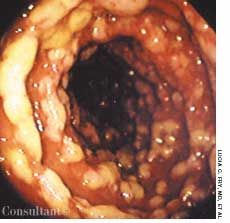
Image courtesy of Luca C. Fry, MD, and Klaus E. Mnkemller, MD.
Click here for the next image
Multiple reddish maculopapular lesions are seen in this unfixed specimen from a patient with Kaposi sarcoma of the stomach. Up to 25% of patients with KS have visceral involvement, and the GI tract often is affected. Patients with GI KS typically are asymptomatic, although gastric outlet obstruction and bleeding have been described. The gross appearances include macular, erythematous maculopapular, and polypoid lesions.
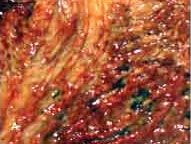
Image courtesy of Colan Ho-Yen, BSc(Hons), MBChB, and Fuju Chang, MD, PhD.
Click here for the next image
A 79-year-old man with a history of congestive heart failure experienced abdominal pain, diarrhea, and dark red rectal bleeding. A flexible sigmoidoscopy revealed normal rectal mucosa; black-blue patchy discoloration that indicated necrosis and submucosal hemorrhage was seen on the mucosa of the sigmoid colon. An emergency laparotomy demonstrated full-thickness necrosis of the sigmoid and part of the descending colon. Signs and symptoms of ischemic colitis are subtle, nonspecific, and unreliable.
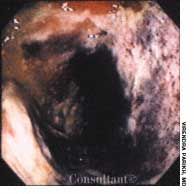
Image courtesy of Virendra Parikh, MD.
Click here for the next image
A 60-year-old woman with a history of iron deficiency anemia was hospitalized because of an episode of melena. An esophagogastroduodenoscopy revealed a submucosal gastric tumor in the antrum, at a distance of 3 cm from the pylorus, in the greater curvature of the stomach. Histologic examination revealed adenocarcinoma, which was most consistent with metastatic colon cancer. Most metastatic cancers present as ulcerated masses or nodules. The presentation as a submucosal gastric tumor, as in this patient, is unusual.
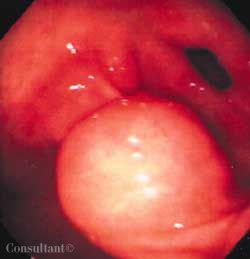
Image courtesy of Luca C. Fry, MD, and Klaus E. Mnkemller, MD.
Click here to return to the first image.
Clinical Tips for Using Antibiotics and Corticosteroids in IBD
January 5th 2013The goals of therapy for patients with inflammatory bowel disorder include inducing and maintaining a steroid-free remission, preventing and treating the complications of the disease, minimizing treatment toxicity, achieving mucosal healing, and enhancing quality of life.
